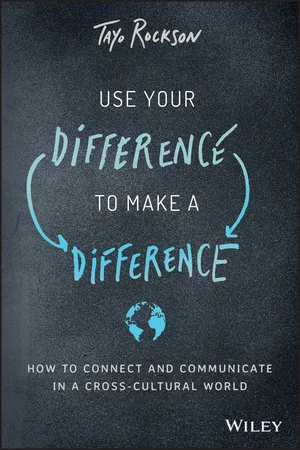
Use Your Difference to Make a Difference
How to Connect and Communicate in a Cross-Cultural World
- English
- ePUB (mobile friendly)
- Available on iOS & Android
Use Your Difference to Make a Difference
How to Connect and Communicate in a Cross-Cultural World
About This Book
Become more culturally competent in an increasingly diverse world
Recent years have seen dramatic changes to several institutions worldwide. Our increasingly interconnected, digitized, and globalized world presents immense opportunities and unique challenges. Modern businesses and schools interact with individuals and organizations from a diverse range of cultural and national backgrounds—increasing the likelihood for miscommunication, errors in strategy, and unintended consequences in the process. This has also spilled into our daily lives and the way we consume information today. Understanding how to navigate these and other pitfalls requires adaptability, nuanced cross-cultural communication, and effective conflict resolution. Use Your Difference to Make a Difference provides readers with a skills-based, actionableplan that transforms differences into agents of inclusiveness, connection, and mutual understanding.
This innovative and timely guide illustrates how to leverage differences to move beyond unconscious biases, manage a culturally-diverse workplace, create an environment for more tolerant schooling environments, more trusted media, communicate across borders, find and retain diverse talent, and bridge the gap between working locally and expanding globally. Expert guidance on a comprehensive range of topics—teamwork, leadership styles, information sharing, delegation, supervision, giving and receiving feedback, coaching and motivation, recruiting, managing suppliers and customers, and more—helps you manage the essential aspects of international relationships and cultural awareness. This valuable resource contains the indispensable knowledge required to:
- Develop self-awareness needed to be a cross-cultural communicator
- Develop content, messaging techniques, marketing plans, and business strategies that translate across cultural borders
- Help your employees to better understand and collaborate with clients and colleagues from different backgrounds
- Help teachers build safe environments for students to be themselves
- Strengthen cross-cultural competencies in yourself, your team, and your entire organization
- Understand the cultural, economic, and political factors surrounding our world
Use Your Difference to Make a Difference is a must-have resource for any educator, parent, leader, manager, or team member of an organization that interacts with co-workers and customers from diverse cultural backgrounds.
Frequently asked questions
Part I
Educate
1
Education
Education is the most powerful weapon which you can use to change the world.—Nelson Mandela
2
Education of Self (Internal Culture)
What Does Your Bias Say about You?
Understanding Unconscious Bias
- Our worldviews: how we see people and the world.
- Our attitudes and behaviors: how we react toward certain people or groups of people based on our worldviews.
- Our attention: what we pay attention and listen to, consciously or unconsciously.
- Our comfort level: how safe or unsafe we feel in certain situations.
- Affinity bias: Affinity bias occurs when we see someone we feel we have an affinity with (e.g., we support the same teams, we attended the same college, we come from the same place, or they remind us of someone we know and like). For example, I am obsessed with Harry Potter, Lebron James, and Manchester United, so if I come across anyone who shares an affinity for those things, the chances of me wanting to connect with that person are probably high.
- Attribution bias: Attribution refers to how we explain behavior or the cause and effect of something. It's attaching meaning to something, so attribution bias would be attributing someone's behavior to their intrinsic nature. For example, say you're driving and someone cuts you off. You notice that the person has a New Jersey license plate, so you immediately assume that the driver is is careless because he's from Jersey. Now anytime you see a driver from Jersey, your bias is activated. What is missing in this scenario is the failure to assess the situational factors that led to your getting cut off. Instead, a leap was made to attach a meaning to the intrinsic nature of someone.
- Beauty bias: This refers to how we judge people based on their physical appearance, especially when they are considered attractive. Unconsciously, many of us associate appearance with personality, so, for example, a tall person might translate as a good leader to you or a beautiful person might be perceived as more trustworthy.
- Confirmation bias: This refers to the tendency to gather and process information by looking for, or interpreting, information that is consistent with your existin...
Table of contents
- Cover
- Table of Contents
- Foreword
- Acknowledgments
- Introduction
- Part I: Educate
- Part II: Don't Perpetuate
- Part III: Instead, Communicate
- Glossary
- About the Author
- Index
- End User License Agreement